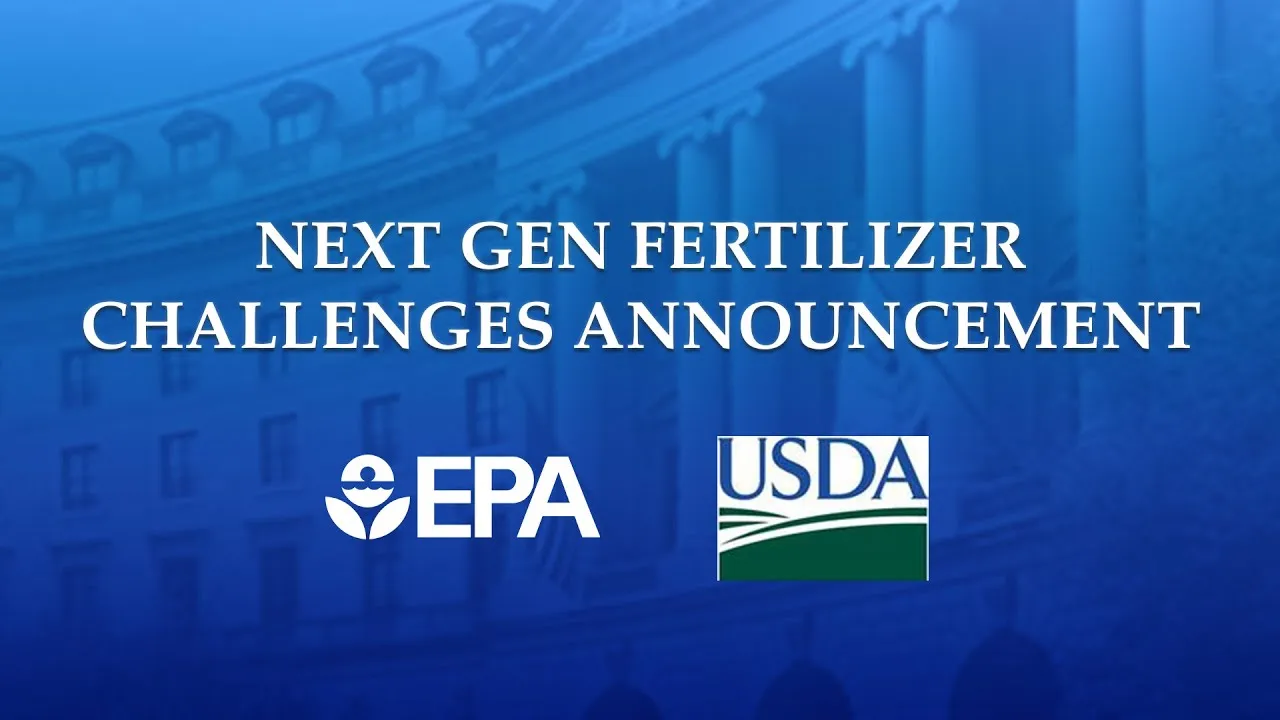


L'USDA et l'EPA annoncent les gagnants du concours d'innovations en matière d'engrais de nouvelle génération
WASHINGTON, le 19 octobre 2021 – Le ministère de l'Agriculture des États-Unis et l'Agence américaine de protection de l'environnement (EPA) ont annoncé aujourd'hui les lauréats du Défi Innovations en matière d'engrais de nouvelle génération, deuxième volet d'un partenariat et concours conjoint USDA-EPA sur les engrais à efficacité améliorée (EEF) pour promouvoir la durabilité agricole aux États-Unis. L'objectif du concours est d'améliorer l'efficacité des engrais afin d'accroître les rendements des cultures tout en réduisant leur impact sur l'environnement.

Les lauréats du concours ont soumis des concepts de technologies innovantes permettant de réduire les effets environnementaux de l'azote et du phosphore issus de l'agriculture moderne, tout en maintenant, voire en augmentant, les rendements des cultures. Les solutions gagnantes utilisent des nanoparticules qui nécessitent moins d'engrais et libèrent des nutriments à la demande des plantes en croissance, puis se biodégradent en substances inoffensives, voire en nutriments ; elles favorisent une croissance accrue des plantes avec un apport d'engrais identique ou inférieur ; et d'autres approches.
“Farmers, ranchers, and foresters are well-positioned to be leaders in tackling climate change through technological innovation,” said Acting USDA Chief Scientist Hubert Hamer. “Through programs like the Next Gen Fertilizer Innovations Challenge, USDA is partnering with the private sector to find new climate-smart solutions that are good for farmers and good for the environment.”
“The goal of the challenge is to develop and use innovative and affordable technologies to reduce environmental impacts of modern agriculture on our air, land, and water, while maintaining agricultural productivity and profitability,” said Wayne Cascio, acting principal deputy assistant administrator for science for EPA’s Office of Research and Development. “We are excited about the possibilities and continued new work in this area.”
The winning concepts include a range of solutions that can improve environmental outcomes, including reduced nitrous oxide emissions—the largest source of greenhouse gas emissions from agriculture— while maintaining or increasing crop yields.
Les gagnants comprennent :
Solutions de niveau 1 (prix de 17 500 $) :
Dr. Christopher Hendrickson, Aqua-Yield Operations LLC, Draper, Utah, pour un engrais nano-intelligent.
Taylor Pursell, Pursell Agri-Tech, Sylacauga, Ala., for “Urea 2.0,” which replaces the conventional urea core with a customizable mixture of materials to provide fertilizers tailored to local needs.
Solutions de niveau 2 (prix de 10 000 $) :
Dr. Kuide Qin, Verdesian Life Sciences, Cary, NC, pour avoir utilisé des technologies de mélange innovantes pour améliorer les performances de la nitrapyrine standard de l'industrie pour une efficacité plus longue, moins de lixiviation des nitrates et la prévention de la corrosion des équipements agricoles.
Dr. Catherine Roue, Fertinagro Biotech International, Portage, Mich., for “Phosphate Liberation Booster” technology, which uses secretions from phosphate-starved plants to boost plant uptake so less fertilizer may be added and legacy phosphorus can be accessed.
Chandrika Varadachari, Agtec Innovations Inc., Los Altos, Calif., for “Smart-N,” which is a smart-fertilizer that releases nutrients on-demand by the crop and which creates a chemical “cage” for urea that dissolves into plant nutrients.
Solutions de niveau 3 (mention honorable) :
Dr. Jaroslav Nisler, de l'Institut de botanique expérimentale de l'Académie tchèque des sciences, République tchèque, pour l'utilisation de dérivés de l'hormone de croissance végétale MTU, qui aide à créer des périodes de croissance plus longues, une protection contre le stress, des plantes plus grandes et potentiellement moins de pertes de nutriments par unité d'engrais appliquée.
Dr. Leanne Gilbertson, Civil and Environmental Engineering Department at the University of Pittsburgh, Penn., for creating a “protected fertilizer package,” which can carry nutrients through soil pores to the area around the plant roots.
Dr. Robert Neidermyer, Holganix LLC, Aston, Penn., for “Bio 800+,” a microbial inoculant that harnesses the power of over 800 species of soil microbes, kelp, and other soil amending ingredients to promote greater crop production and plant health.
Paul Mullins, Brandon Products Ltd., Ireland, for “BBS-1,” a biostimulant derived from seaweed extract that is applied as a fertilizer coating to improve nitrogen-uptake in root cells.
L'USDA et l'EPA coordonnent les défis de l'EEF avec le Fertilizer Institute (TFI), l'International Fertilizer Development Center (IFDC), The Nature Conservancy (TNC) et la National Corn Growers Association (NCGA).
The competition launched on August 26, 2020. Part two of the first challenge, “EEFs: Environmental and Agronomic Challenge,” is ongoing. More information can be found at: www.epa.gov/innovation/next-gen-fertilizer-challenges.
USDA touches the lives of all Americans each day in so many positive ways. In the Biden-Harris Administration, USDA is transforming America’s food system with a greater focus on more resilient local and regional food production, fairer markets for all producers, ensuring access to safe, healthy and nutritious food in all communities, building new markets and streams of income for farmers and producers using climate smart food and forestry practices, making historic investments in infrastructure and clean energy capabilities in rural America, and committing to equity across the Department by removing systemic barriers and building a workforce more representative of America. To learn more, visit www.usda.gov.
-
Zinc Chloride: a reliable stabilizer for ice dye color salts in the dye industryNouvellesAug.11,2025
-
Propargyl Alcohol: A Multifunctional Chemical Additive in the Industrial FieldNouvellesAug.11,2025
-
Phosphorus Pentasulfide: a special material that combines moisture absorption and basic chemical valueNouvellesAug.11,2025
-
Natural Pesticides: The Environmental Choice for Green Prevention and ControlNouvellesAug.11,2025
-
Grass Pesticide: the invisible guardian of green lawnsNouvellesAug.11,2025
-
Dimethyl Sulfoxide: Key Assistance in Sample Management and Drug ScreeningNouvellesAug.11,2025
-
Uncover the Benefits of Sodium ChlorateNouvellesJun.24,2025


















